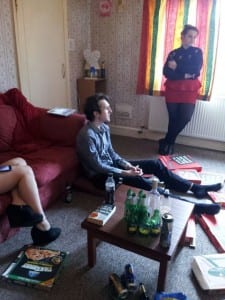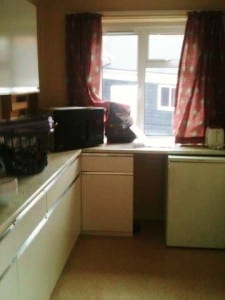
Working in a house is very different to what any of our group as ever done before, but in another way it’s very familiar to all of us because it is a home. Home is something everyone has had once in their life. It defines you, I feel by walking around a person’s house you can really get a sense of the person they are. Walking around the house on west parade you instantly got a sense of familiarity from the old fashioned carpets and curtains to the patterned wall paper.
The room I felt most comfortable in was the living room; this is because to me the front room is the main body of a house. Its full of people and it is the room where I personally feel the most relaxed being able to relax and feel safe in your home is the most important thing to me.
I feel the people you live with make your home what it is. When you’re surrounded by people or even just one person you can relax in your front room even with the curtains open, but as soon as you’re on your own in your house everything seems to change you feel on edge and take a lot more care in making sure all the doors are locked and the curtains are shut so that nobody can see that you are alone. You suddenly start thinking about being on your own in such a big space and think of all the dangers that could happen to you. Being able to relax and feel safe is to me the most important aspect, one subject that came up in our last seminar is that of people moving away from home to university and how much of a drastic change it is. Living somewhere else that isn’t always of great comfort to you is a hard situation to get used to also living with people that you may not necessarily put yourself with in everyday life. This links to the title of my blog, explaining that everybody knows where they are from and where there home is but sometimes to succeed and get where you want to go in life you have to ‘roam’ and leave the comfort of your home and explore and find new places to call home. Choosing who you want to live with in second year at university is very different to the situation in first year when there is not a choice, you are putting your faith in the fact you will be comfortable to live with them, and together you find somewhere that can be ‘homelike’ defined in the oxford universal dictionary as “like home; suggestive of home; homelyLittle, ((W (1969) “The Oxford Universal Dictionary”, London: Oxford University Press p. 914))
A very interesting thing in the front room to me was the window and how big it was, if you stood on the back garden you could see everything happening in the house. This subject has always interested me that looking through someone’s window you are looking into their life. It is very interesting how people live very different lives. Alfred Hitchcocks ‘rear window’ a story of a man watching his neighbours and seeing their various different characters that live on his street. Just shows how your home can be a window to your life someone could be watching it like they would a performance at a theatre. In Mike Pearson’s chapter ‘provisional spaces’ ((Pearson, Mike (2010) Site-Specific Performance)), Basingstoke: Palgrave Macmillan.he talks about the distinct differences between a site specific performance and normal performance in a theatre. He talks about how the auditorium creates ‘control’ and you know when the performance is going to start and end. The end of the show is always known by the shutting of the curtains. One idea that came to me while reading the chapter was how we can incorporate this into the new space we are working with. As the garden on west parade is a reasonable size, the audience could stand there and watch the performance through the window and as the action that is happening stops somebody gets up and shuts the curtains showing the end. This is an idea that I would like to expand and work on in different rooms in the house.
